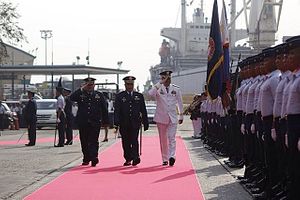Last week, reports surfaced that Japan could potentially move forward with a deal that would see it deliver tens of thousands of helicopter spare parts to the Philippines. Though talk of such a deal is far from new and there is a lot that still remains undisclosed, it nonetheless reflects Tokyo’s ongoing efforts to boost its defense ties with Manila as well as other Southeast Asian states in spite of the challenges it continues to face in doing so.
As I have noted before, though relations between Japan and the Philippines date back decades, ties in the defense domain had been strengthening significantly under Prime Minister Shinzo Abe and Philippine President Benigno Aquino III, with not just capacity-building cooperation, but a landmark agreement on defense equipment and transfer signed last March (See: “Japan-Philippines Defense Relations Under Duterte: Full Steam Ahead?”).
Though Philippine President Rodrigo Duterte’s foreign policy approach has complicated the growing strategic convergence between the two countries somewhat, bilateral defense ties nonetheless continue to be nurtured at the working level because of the common interests the two sides continue to share (See: “What’s Next for Japan-Philippines Defense Relations Under Duterte?”).
Japan’s broader defense engagement of Southeast Asian states has also continued, with the more high-profile developments including the unveiling of the Vientiane Vision last year as well as the June South China Sea tour by ASEAN defense officials on board the Japanese helicopter destroyer JS Izumo (See: “Japan Reveals First ASEAN Defense Initiative With ‘Vientiane Vision’”).
On August 10, a Reuters report cited anonymous defense sources in both Japan and the Philippines as confirming that a deal on spare parts for Manila’s UH-1H combat utility helicopters (or “Huey”) helicopters would soon be realized. A senior Philippine Air Force commander was quoted as saying that around 40,000 spare parts, retained by Japanese forces, would soon be handed over to Manila in a “demonstration of the robust strategic partnership and cooperation of the two allies.”
The deal itself is far from new. Indeed, in March, Philippine Defense Secretary Delfin Lorenzana had publicly disclosed some details on the sidelines of the transfer ceremony of two Beechcraft King Air TC-90 aircraft – a deal which, as I have discussed previously, marked the first time that Tokyo had leased military aircraft to a foreign country since the lifting of a self-imposed ban on weapons exports. At the time, Lorenzana had revealed that the Philippine Department of National Defense (DND) was already in talks with Japan’s Minister of Defense’s Acquisition, Technology, and Logistics Agency (ATLA) about a deal for spare parts.
Such a move would make sense for both sides. For Manila, the acquisition of spare parts would be a boost as it would allow it to ensure the full serviceability and readiness of its helicopters and potentially extend their already long service life. That is no small deal because the Philippine Air Force remains quite limited in its capabilities despite some improvements in recent years (See: “Where is the Philippines’ Air Force Modernization Under Duterte?“). And for Tokyo, this would constitute yet another example of substantive defense cooperation with Southeast Asian states amid the struggle that it has faced at times to get the ball rolling as it has been loosening its decades-old defense restrictions under Abe.
Yet for all the hype that the Reuters report has received since its release, we still do not know some basic specifics, such as what its exact value will be and how it will be structured. Indeed, a spokesman for the procurement agency of Japan’s defense ministry is quoted as saying that while there is a desire to push ahead with defense equipment cooperation, Tokyo is at this stage still looking at various options and there is “nothing concrete” at this stage.
As I have pointed out with respect to other potential transactions involving Japan and ASEAN countries, from eventually realized ones like the Beechcraft King Air TC-90 aircraft or potential ones like a deal for Japan to provide Malaysia with maritime patrol aircraft, details, such as whether equipment can be offered for free or for a lower price, can often be ‘make or break’ issues (See: “Will Japan Give Malaysia Maritime Patrol Aircraft?”).
So while the realization of a helicopter spare parts deal would no doubt make sense from the perspective of broad strategic convergence between the two sides and their respective interests and the will to get things done is there, it is worth waiting for the specific technical details before getting carried away.































